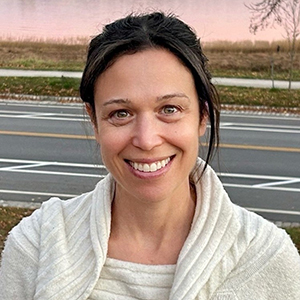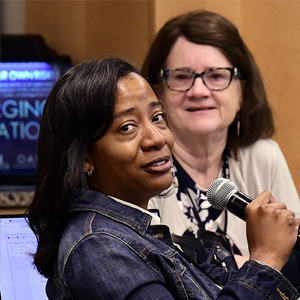 Rick Woychik, Ph.D., directs NIEHS and the National Toxicology Program. (Image courtesy of NIEHS)
Rick Woychik, Ph.D., directs NIEHS and the National Toxicology Program. (Image courtesy of NIEHS)Scientific conferences that I attend often focus on bad things in our environment, such as chemical exposures that can negatively affect health outcomes. After a while, one begins to wonder about the other side of the equation: What about the good things in our environment that potentially help to reduce risks associated with those exposures?
Last June, NIEHS hosted a two-day workshop — “Can Nutrition Modify the Impact of Environmental Exposures on Autism?” — that featured fascinating discussions on how nutrients such as folic acid and polyunsaturated fatty acids may help to reduce autism risk.
Autism is a complex condition influenced by genetics and, potentially, environmental exposures that occur during key windows of susceptibility, such as pregnancy. Participants noted that much more research is needed to uncover the potential role nutrition may play in modifying the effects of autism-related exposures, like air pollution. Nevertheless, emerging research in this area looks promising, and one NIEHS grantee is doing her part to advance the science.
Kristen Lyall, Sc.D., an epidemiologist at Drexel University who co-organized the June workshop, recently spoke with me about her efforts to expand research at the intersection of nutrition, exposures, and autism. She discussed the role of maternal diet, highlighted important knowledge gaps she is working to fill, and shared her unique career path.
Reducing risks caused by exposures
Rick Woychik: What were some of your takeaways from the recent NIEHS workshop on nutrition, exposures, and autism?
 Lyall is an associate professor in the Modifiable Risk Factors Program in the A.J. Drexel Autism Institute. (Photo courtesy of Kristen Lyall)
Lyall is an associate professor in the Modifiable Risk Factors Program in the A.J. Drexel Autism Institute. (Photo courtesy of Kristen Lyall)Kristen Lyall: Sometimes I joke that if you spend a day at an environmental epidemiology conference, you walk away with a feeling of “Oh, no, everything in the environment is terrible.” But I’ve always liked the idea of trying to focus on things that are actionable. In other words, what can we do to help mitigate our exposures? And this workshop really brought up these topics.
It is not feasible to totally reduce or eliminate our exposures to environmental chemicals, which are ubiquitous in modern life. So, this idea that the foods that we eat, the lifestyle choices that we make, and so forth can help to modify our risks from exposures really intrigues me.
I was excited to help organize the workshop because it really brought together a lot of my interests. I’ve been studying the role of prenatal diet in child neurodevelopment for some time, and I have a growing interest in the role of environmental chemicals. I also think it’s important to note the potential for common pathways here — that folic acid supplementation, an anti-inflammatory diet, polyunsaturated fatty acids, and other nutritional factors may act on the same pathways that we know these environmental chemicals are acting on to influence neurodevelopmental outcomes.
The idea that nutritional factors may help to lessen the effects of those chemicals is a major interest of mine, but there isn’t a lot of research out there yet. The workshop was great because we were able to connect with other scientists from diverse fields with expertise in this area, share ideas, think about our research methods, and discuss knowledge gaps.
Addressing important knowledge gaps
RW: What knowledge gaps have you identified, and how is your research addressing them?
KL: If we compare diet and nutrition to other risk factor research in autism, and even research in neurodevelopment more broadly, there's certainly much less work related to maternal diet. Another knowledge gap is that almost all of the existing research has examined one nutrient at a time, or one supplement at a time, but that’s not very representative of real-world nutritional exposures, which involve complex interactions of multiple substances. In addition, there haven’t been many studies examining dietary patterns, which represent a more comprehensive assessment of diet, and associations with neurodevelopmental outcomes.
 Learn more about how NIEHS-funded scientists are advancing autism research. (Photo courtesy of Nikosnikossss / Shutterstock.com)
Learn more about how NIEHS-funded scientists are advancing autism research. (Photo courtesy of Nikosnikossss / Shutterstock.com)Also, there are only a small number of studies that have looked at interactions between nutrients and chemicals. Some studies have begun to look at folate and air pollution, and folate and pesticides, but work in this area is emerging, and we can certainly expand our consideration of dietary factors. And, of course, the existing gaps also present opportunities for next steps. I think there is a lot of exciting research on the horizon.
Some of my ongoing projects are trying to address these gaps. Currently, I’m leading a study funded by NIEHS looking at whether certain nutrients can modify the association between prenatal air pollution exposure and autism-related outcomes. We are examining individual nutrients such as folate and vitamin D but also a broader diet, and we are looking at critical time windows when nutritional factors might most influence associations.
Communicating about a complex condition
RW: That sounds like fascinating work, and I look forward to learning what you discover going forward. Now, I’m curious about another important aspect of all of this, which involves communication. Obviously, autism is a complex condition influenced by many factors, and when we talk about prevention, there are many variables at play. What are your thoughts on how to effectively communicate your science and the potential benefits of nutritional interventions?
KL: I just want to note that I want to be careful when I use the term risk and talk about prevention because autism today is a broad diagnosis, and it includes many different ranges of challenges but also strengths. Risk is really a statistical term, and we're not trying to prevent neurodiversity or some of the strengths that come along with autism. So, when we're talking about prevention or reducing risk, it’s about reducing challenges and improving function.
Regarding communication, that is a topic I’m deeply interested in. Working in the field of prenatal risk factors for autism, I think it's so important to really hone communication and very carefully and thoughtfully put out messaging in a way that doesn't place blame or burden on these families because they already have so much that they're working through.
It is critical to point out that autism is a multifactorial condition with no one cause, so in the vast majority of cases, it's not just one factor that causes a child to develop autism. Often, people may be looking for the “one” answer, and I think it's important that we remind them there are many causes of autism, and two individuals with the condition may have totally different causes, and different sets of challenges.
When communicating about a specific study, I think it’s important to share the take-home message, the key finding, and to put that in the context of relative risk. For example, you might tell people that you observed increases in odds of having a child with autism for individuals who were exposed to very high levels of a given chemical, relative to those with lower levels. And in the case of a preventative strategy, you might say that you observed reductions in odds of autism with higher prenatal levels of a certain nutrient relative to those with very low levels.
Providing that context is critical for ubiquitous exposures because it clarifies that increases in the likelihood of an outcome depend on the level of the exposure, not just whether the exposure is present. That lets people know that not everyone with the exposure gets the outcome. In addition, I think it is important to provide actionable strategies for reducing exposures or perhaps consuming more of a nutrient that can help to modify the potentially harmful effects of the exposures. And all of this should be communicated in a way that does not place blame or cause more stress — which I think is particularly important for pregnant populations.
(Rick Woychik, Ph.D., directs NIEHS and the National Toxicology Program.)









